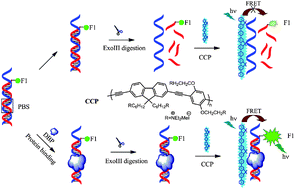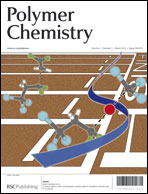The sensitive, ratiometric and simple detection of sequence-specific DNA-binding proteins is of paramount importance for proteomics, genomics and biomedicine. We describe herein a novel target-mediated fluorescence resonance energy transfer (TMFRET) strategy for the homogeneous and visual detection of sequence-specific DNA-binding proteins. This conjugated polymer-based optical biosensor was demonstrated using a model target DNA-binding protein nuclear factor-kappaB (NF-κB), which is a key transcription factor involved in a number of important transcriptional regulatory networks. A fluorophore-labeled, double-stranded DNA probe bearing an NF-κB-binding site was designed to identify the target protein. Combining the protein with the probe could protect the probe from digestion by exonuclease III, yielding a high-efficiency FRET from the cationic conjugated polymer to the fluorophore label on the probe. The results revealed a highly sensitive, selective, colorimetric and turn-on detection of the purified recombinant NF-κB and HeLa cell nuclear extracts. The limit of detection for the target protein in nuclear extracts was estimated to be 1 × 10−5 μg μL−1, which is 5000-fold more sensitive than previously reported methods. This strategy offers a new method for the reproducible, low-cost and simple detection of DNA-binding proteins because an average percent relative standard deviation of less than 5% was obtained. The results of the assay can also be seen by the naked eye with the help of a transilluminator, which is promising for detecting DNA-binding proteins in human samples for low-cost medical diagnoses and for the high-throughput screening of new drugs targeted to DNA-binding proteins.

You have access to this article
 Please wait while we load your content...
Something went wrong. Try again?
Please wait while we load your content...
Something went wrong. Try again?


 Please wait while we load your content...
Please wait while we load your content...